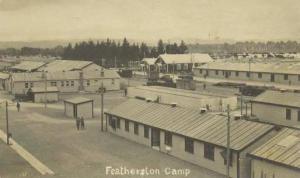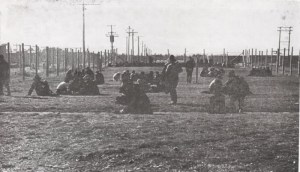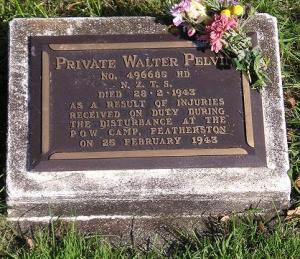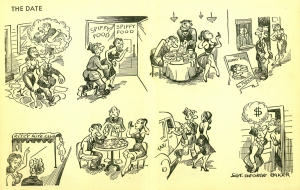Featherston, NZ – POW Camp
During WWI, Featherston was the largest military training camp in New Zealand, housing 7500 men. It was dismantled after the war ended. In September 1942, the US requested that it be re-opened as a prisoner of war camp for the captured Japanese troops of Guadalcanal.
Approximately 900 Japanese and Korean men were housed in the camp with the senior Japanese officer being Lt. S. Kamikubo of the Imperial Japanese Navy. The prisoners consisted of Koreans and labor units who had worked on Henderson Field and about 250 Japanese, at the time of the POW uprising. Lt.Colonel D.H. Donaldson was the camp’s commandant.
The Japanese prisoners were from the army, navy and air force with the majority of them from the cruiser IJN Furutaka, which was sunk during the Battle of Cape Esperance. The remaining 19 men were the extent of the surviving crew from the destroyer, Akatsuki. It was this group that refused to assist in the work parties and staged a sit-in on 22 February 1943.
A guard fired a warning shot, which appeared to have injured Lt. Adachi Toshio. This led to an apparent charge by 250 rock-throwing prisoners. The guards opened fire with rifles and sub-machine-guns. Forty-eight POWs and one New Zealand guard were killed.
An official inquiry cleared the guards of wrongdoing by judging that they acted in self-defense. It blamed the incident on cultural differences worsened by a language barrier. Among the issues was the Japanese being unaware that under the 1929 Geneva Convention, compulsory work by the prisoners was allowed. The Japanese government rejected the court’s findings.
In September 1945, the prisoners told a neutral inspector that they were concerned about repatriation as honorable citizens; provisions would be necessary or they should be given asylum on a Pacific island. They feared a mass suicide might result otherwise. The POWs also worried about the treatment in New Zealand when news of the conditions in the Japanese POW camps holding their men was released.
The prisoners were transported in two trains from Featherston to Wellington and embarked on 30 December upon two large American tank landing vessels, LST 273 and LST 275, under Lt.Comdr, R.P. Rudolph, for Japan.
The Featherston uprising would inadvertently be one of the reasons for the Cowra POW camp incident in August 1944, to be posted later in this series.
Click on images to enlarge.
#####################################################################################################
Military Humor – everyone’s favorite soldier….
#############################################################################
Farewell Salutes –
Brian Arsenault -Northborough, MA; US Army, Afghanistan, 82nd A/B
Eric Bradshaw – Wandoan, AUS; RA Air Force # 124491
Wayne Dyer – Detroit, MI; US Navy 
Harold Greene – Schenectady, NY; US Army, Afghanistan, Major
Dean Jones – Decatur, IL; US Navy, Korea (beloved actor)
Jerome LaVatch – Rutland, VT; US Navy, WWII
Brian Maples – Auckland, NZ; RNZ Army # 207340, Canterbury Regiment
Robert Oliphant – Bryant, AR; US Army, WWII, WTO, 8th Infantry Division
Billy Stevens – Bullhead City, AZ; UA Army (Ret. 26 years), Korea, Vietnam, Sgt. Major
Edward VanNordheim – Licoln, NE; US Army, WWII, PTO, Bronze Star
##########################################################################
Posted on September 16, 2015, in WWII and tagged 1940's, Australia, History, Home Front, New Zealand, Pacific War, POWs, Tributes, USA, veterans, WWII. Bookmark the permalink. 80 Comments.












Great post! It is certainly one of the most tragic events to occur in New Zealand during the war. Thanks for sharing some of our history!
LikeLiked by 1 person
Thank you very much. Your expertise as a historian and native New Zealander makes this compliment even more impressive.
LikeLike
Wonderful bit of lost history, gpcox. It was amazing so many IJN survivors of boat sinkings were taken on board/rescued. I’m sure the crew showed tremendous restraint.
These POWs you’ve written about were some of the more fortunate ones bring repatriated so soon. Although my dad doesn’t say much, he was interrogating Japanese prisoners being returned from Russia, China and Korea as late as 1948, being part of G-2.
LikeLiked by 1 person
I never did understand why Russia held on to their POWs so long, has your dad given any clue about this? I wonder if those prisoners even knew the war was over? Good to hear from you again, Koji – you’ve been missed!!
LikeLike
Very interesting. I’d read about this Incident, but I am struggling to remember where. My memory is that it was being used as a justification to ill-treat Allied POWs and to force them to work.
LikeLiked by 2 people
I have been thinking about you more and more lately, Hilary – I happen to be reading ‘Elephant Company’! Let me know if you remember your thoughts on Featherston.
LikeLike
I will. It will be somewhere in one of the many books I read… very few have indexes, maybe it will come to me.
LikeLike
Cultural differences; ummm – this reminds me of my brother who was forced into an organised fight in an Australian country boarding school in the 60s. There he was, the only Chinese boy there, half the weight of his opponent, surrounded by big Aussie lads cheering for their ‘man’. He didn’t know the Queensbury rule so when he started using his martial art to strike and kick, he was branded as a ‘dirty fighter’. Still, he was recognised as a fighter and no one picked on him anymore. The beefy opponent was down and no one was up for a rematch. Afterwards he said, a fight is a fight, isn’t it?
LikeLiked by 1 person
Hey – if no one explained the rules – they can’t complain. Thanks for the story, Mary.
LikeLiked by 1 person
How ironic, the Japanese worried about the conditions in the Japanese POW camps for their own soldiers, what a massive hypocritical attitude, when they ignored the Allies concerns about the treatment of our own soldiers in POW camps.
Enjoyed Sad Sack, reminds me of my early army days.
LikeLiked by 1 person
Yup, I found that ironic myself. In fact I re-read the information over a few times – thought maybe I was distracted and mis-interpreted it. Were YOU a ‘sad sack’ soldier – I really can’t picture you being that goofy!
LikeLiked by 1 person
Not exactly a Sad Sack soldier, but spent my money chasing girls with expensive tastes, was always broke.
LikeLiked by 1 person
Gotcha – NOW that I can see!!
LikeLike
E frumos sa vezi ca cineva s-a gandit la tine, e frumos sa vezi ca, desi nu cunosti real pe nimeni, se leaga prietenii virtuale pline de frumusete…este usor sa te gandesti ca toti prietenii virtuali care iti trimit comentarii … se gandesc la tine, e frumos si parca nu te mai simti singur. Iti multumesc prieten drag, ca pentru o clipa te gandesti la mine si ca vrei sa imi faci o bucurie. Toti avem prieteni, toti avem cunostinte, dar viata, de multe ori, nu ne lasa sa luam legatura cu ei de cate ori vrem, aici in fiecare dimineata si seara ne salutam cu impresii si imagini virtuale. E FRUMOS si PLACUT daca totul e civilizat si cu bun simt! O seara minunata dragi mei!

It’s nice to see that someone thought about you, it’s nice to see that even though you do not know anyone real, virtual friendships full of beauty … is easy to think that all your virtual friends send comments … think of you is beautiful and if you never feel alone. Thank you dear friend, that for a moment and think of me as you do me a joy. We all have friends, we all have knowledge but life often leaves us to make contact with them whenever we want, here every morning and evening greeting impressions and virtual images. It’s beautiful and pleasant if everything is civilized and good sense! A wonderful evening my dear!

LikeLike
What a lovely sentiment, Ileana, thank you very much! I appreciate you taking the time for such kind words and adorable pictures. The kiss is so cute.
LikeLiked by 1 person
This link takes you to an interesting video on the memorial garden associated with the POW camp. http://www.nzhistory.net.nz/media/video/featherstons-camp-roadside-stories The cherry trees should be looking particularly beautiful at the moment. Your post indicates that many of the POWs were Koreans. Many of them would have been keen to go home I imagine.
LikeLiked by 2 people
Thank you, Ann, that link is a fantastic addition to the post!! And I agree, I’m sure the Koreans wanted to get home as soon as they could. Thanks for taking the time to come by and contribute!!
LikeLiked by 1 person
I live about 70 km from the Featherston camp site – there is a memorial there to the Japanese POWs who died in 1943, reading ‘Behold the summer grass: all that remains of the dreams of warriors’. When I last visited, a wreath had been recently left there by the JMSDF. The little park also had a small population of wild bantams pecking around it! I really must publish some of the photos on my blog – including a wider-angle pic I took of Pelvin’s grave, which shows a bit more than the photo you have here.
I covered the events in some of my histories of NZ’s involvement in WW2 (‘Pacific War’, especially, which is about to be reissued, I’m pleased to say). One of the more intriguing stories about this event has been the recent suggestion that the New Zealand government somehow ‘suppressed’ the story. That is not so – it was subject to the usual wartime censorship but later written, explicitly and openly, into the official histories. My take is that a lot of it could be put down to miscommunication, cultural differences, and the fact that there was a good deal of anti-Japanese sentiment in New Zealand at the time. This stemmed back well before the war – in my academic work I traced it to 1905 and the Russo-Japanese War. There is, I think, no question of culpability on both sides.
LikeLiked by 4 people
Thank you very much for sharing your expert research into this, Matthew. I try to find a copy of some of your books every few weeks that fit within my budget, but it’s even better to hear directly from the author. I appreciate you taking the time for us.
LikeLiked by 1 person
Thanks – I’m very happy to contribute! I really must sort out a blog post with some of my pictures of the site. It was a traumatic moment in NZ’s history. At the time, of course, emotions ran very high – and continued to do so for some time afterwards. Today, as the memorials there reveal, there is forgiveness and remembrance by all sides; and to me, that is one of the poignancies of that event.
LikeLiked by 3 people
I sincerely agree with your point on forgiveness and remembrance. Thank you again.
LikeLiked by 1 person
Interesting, I didn’t even know about the POW camp in NZ!
LikeLiked by 1 person
I love discovering little known stories, you made my day! Thanks for commenting.
LikeLike
They had the temerity to complain and refuse to comply with legitimate orders? Had the positions been reversed I have no doubt that they would have had no trouble or conscience in executing THEIR POWS’s out of hand.
LikeLiked by 1 person
Good to see you Beari!! Oh, you know very well the consequences if the situations were reversed. I don’t think the number of men lost in their camps and work details can even be estimated.
LikeLike
I fear had it been the other way round executions and beatings would have made the ‘protestors’ change their minds rather quickly. Those who dish it out – the first to complain.
LikeLiked by 1 person
Agreed. I definitely find that to be true!
LikeLiked by 1 person
It’s good to hear about these events, there must be so many more that were forgotten about. For many the war ended 1945 but for many more it continued for a considerable time after. The Poles were a particularly poorly treated people.
LikeLiked by 1 person
You’re right. After the war there was quite a bit that needed doing. Only thing is, the US was expected to fix everything then and the world still feels the same way now.
LikeLiked by 1 person
Indeed. A lot of fixing was required and it takes years to do so. Not an easy task.
LikeLike
Between Europe and Asia – Phew!
LikeLiked by 1 person
There is so much more to war than the big picture. The individual’s stories are fascinating to me!
LikeLike
They bring the reality of war into perspective , don’t they?! That’s why I interrupt the facts and statistics posts with eye witness stories and tributes. Thanks for coming.
LikeLike
That perspective makes your blog so popular!
LikeLiked by 1 person
What a very nice thing to say, Anne. Thank you.
LikeLiked by 1 person
You are most welcome!
LikeLike
This makes one wonder, if the Japanese rejected the notion of compulsory work by POWs, why did they impose it on their prisoners? One of my previous duties while serving in Japan was to make monthly visits to the Japanese Prison at Yokosuka, there to visit with American servicemen imprisoned for serious crimes. These ranged from inflicting serious injury to Japanese citizens, to murder … and all of the prisoners there were serving sentences in excess of twenty years. No one in these prisons spoke English to the American prisoners. If the guards ordered them to do something and did not comply because they did not speak Japanese, the guards would beat them into compliance. Most of the prisoners could speak or understand some Japanese … it became a survival skill. From this article, I guess World War II Japanese adhered to a double standard: one for themselves, and one for non-Japanese.
Thank you for this most excellent blog.
LikeLiked by 1 person
They most certainly did. Americans especially were considered mongrels breeding with anyone or anything, while the Japanese race was Japanese. I glad you found the article interesting.
LikeLike
Great article. So many dead because of 1 warning shot. You’re right the cultural difference would make it difficult.
LikeLiked by 1 person
That was the court’s decision. I feel it was only part of the story. Thank you for visiting, Kathy and I love your new post!!
LikeLiked by 1 person
Yes, and can understand that. You’re right there is probably a lot more to it. Glad you enjoyed the post! What a true friend 🙂
LikeLike
🙂
LikeLiked by 1 person
I am always saddened by how little it takes to spark violence, GP. On another note, I drove by the WW II Japanese interment camp at Tule Lake last week. –Curt
LikeLiked by 1 person
Yup – there you go. There is always another side to the coin. Good to see you, Curt.
LikeLike
Thanks, GP. I am happy to be back. Well, sort of happy… I do love our escapes. 🙂 –Curt
LikeLiked by 1 person
I don’t blame you for that!!
LikeLiked by 1 person
Hey, I am over here now guys 🙂 getting some great affiliates http://woundedwarriortoironman.blogspot.com/
LikeLike
I’m sorry Bruce, I’m not a Google affiliate, but I wish you the best of luck with it and I will leave this link here everyone!
LikeLike
“cultural differences and language barrier” It’s hard to imagine the scene. Given the fight-to-the-death attitude they had, I’m guessing there weren’t nearly as many Japanese prisoners as prisoners being held by Japan.
LikeLiked by 1 person
You brought up an interesting point, Dan. I found an estimate of 19,500 > 50,000 for Japanese surrendered, but that is quite a difference. Perhaps you can locate better sources than I did.
LikeLiked by 1 person
The POWs also worried about the treatment in New Zealand when news of the conditions in the Japanese POW camps holding their men was released and well they should have been.
LikeLiked by 1 person
Very, very true, Alan!!
LikeLike
If the Japanese POWs were worried, that meant they fully understood the treatment being meted out to the Allied prisoners in the Japanese camps. I rather imagine that they knew this before reading about it in the newspapers.
LikeLike
If not from their officers, this news might have come from the reinforcements they received while still on Guadalcanal or even the New Zealanders themselves. I was unable to locate their exact source of information for them. Thank you for your interest in the Pacific side of the war, so many remain wrapped up in the smaller ETO.
LikeLike
I’ve long thought that the ETO garnered more attention because (1) its geography was familiar and accessible and (2) it has an abundant literature which is accessible. Not so for the PTO. The geography is often unknown, and since WW II, the names of places have changed as the colonial powers abandoned their former spheres of influence. There is also the matter of source material. Memoirs, studies, histories, etc. are easily available with regard to the ETO. In comparison, the PTO has not nearly as much. I am sure that there are other factors, but I believe those are the main two.
LikeLiked by 1 person
The ETO had familiarity to it. The people looked the same, so many of our ancestry comes from Europe, etc. Remember universities such as Harvard back then were preaching Aryan ideas – a whole different world back then.
LikeLike
I am not sure how it relates to an interest in the ETO versus the PTO, but by Aryan ideas, I take it your are referring to such foolishness as relates to white man’s (and white woman’s) burden and the need for conversion of the heathen and their corollaries in the East? I think that sort of nonsense was universal and not limited to one particular university, country, ideology or religion. I can’t see how such would drive an interest in the ETO over the PTO. Americans fought and died in both theaters of operation.
LikeLike
I merely singled out one univ. as an example. Our leaders came out of those Ivy League schools and yes there was quite a bit of racial/ancestry prejudice back then, I know nothing about the religious end of it involved. The Europeans, others could relate to – they knew nothing about the Orientals. I am not condemning them for it, it was just how it was in those days.
LikeLike
I wonder how many problems are rooted in a simple lack of understanding of other cultures. I don’t know enough about this incident, but it’s interesting you mention the culture.
LikeLiked by 1 person
That was the court’s decision and in many respects I think it was a portion of the cause. The rest, IMO was as warriors, they were required to cause trouble for the enemy. Thanks for reading, Jacqui.
LikeLike
Tragic, really. Still, one imagines that their fears regarding some tit-for-tat reactions were reasonably enough based. And, one does wonder if there was sufficient understanding of Japanese concepts of honour.
LikeLike
As far as going back to Japan after a POW – I do understand their trepidation and also expecting New Zealanders to retaliate for what the enemy did to the Allied prisoners – do you blame them? The idea of bushido was twisted by people like Tojo to control his troops and urge them to die for the cause. In my opinion, pushing the envelope as far as he did was equal to what some people today call a ‘holy war.’
LikeLike
Very similar, in fact.
Actually, Hitler was pushing buttons of the same kind, based on the ‘superior race’ ideals.
LikeLike
Correct.
LikeLike
I enjoyed reading this. When I was in the 11th grade, I briefly attended high school in Campo, California. It had been a Japanese POW camp during WWII. I would often wonder, while attending classes, what the prisoners had gone through. But I think they were much better off there than participating in the war.
LikeLiked by 1 person
Yes, Camp Lockett made part of it’s area into a POW camp for Italian and German prisoners – I’m sure they were happier as POWs than they ever were in the ETO!! Thanks for bringing that up and sharing your story.
LikeLiked by 1 person
You’re right, they were POWs from the ETO. Thanks for pointing that out.
LikeLike
It’s all coming back to you? Glad to be of service.
LikeLiked by 1 person
I only attended that high school for about two months. And many years ago. I usually can’t even remember what I had for dinner the night before.
LikeLike
I know THAT feeling!!
LikeLiked by 1 person
Cultural differences, indeed
LikeLiked by 1 person
Isn’t that a hoot!! 🙄
LikeLiked by 1 person
A really wonderful blog post about a topic I knew nothing about. It’s a pity that no interpreters were available. They might have used Japanese-Americans for this.
On March 4th and 5th 1919, in a military camp in north Wales, the British shot dead five mutinous Canadians and wounded 23. Perhaps the Japanese were lucky it was New Zealanders guarding them!
LikeLiked by 1 person
That’s a story I knew nothing about, John. I guess you’re right about the Japanese being lucky they were in NZ.
LikeLike
It is hard to believe that they were unaware that they could be made to work, given the facts about the way they worked allied prisoners to death in Burma. I have no doubt that they were better treated than any of the prisoners they were in charge of.
Best wishes, Pete.
LikeLiked by 1 person
You know they were treated better – and I believe they knew it too! I would think this was only an excuse to create a bit of chaos for the enemy (NZ). Thanks for stopping in, Pete.
LikeLike
There must have been many of those.
Interesting fact.
LikeLike
With such dramatic cultural differences, that is quite possible.
LikeLike
Excellent little piece of unknown history, thanks for taking the time!
LikeLiked by 2 people
My pleasure, Steve.
LikeLike